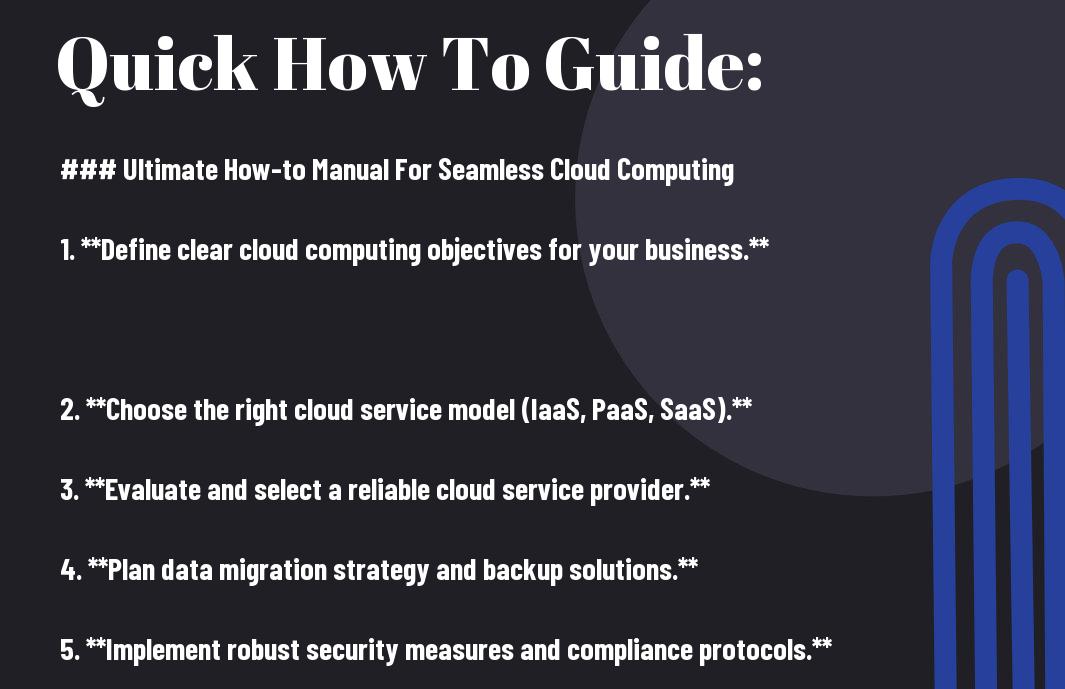Seamless Cloud Computing Many businesses today are turning to cloud computing as a way to enhance performance and reduce costs. As I navigated this landscape, I discovered that implementing a seamless cloud experience requires careful planning and execution. In this ultimate manual, I will share my important tips and insights to help you avoid common pitfalls, maximize your resources, and ultimately achieve a successful transition to the cloud. With the right knowledge, you can harness the power of cloud technology to elevate your operations and optimize your workflow.
Table of Contents
Key Takeaways:
- Integration Strategies: Effective ways to seamlessly integrate cloud services to optimize performance and reduce downtime.
- Cost Management: Techniques for monitoring and controlling cloud expenses to maximize ROI and ensure budget adherence.
- Security Protocols: Essential security measures and best practices to safeguard data in the cloud environment, minimizing risks and ensuring compliance.

Understanding Cloud Computing
Before exploring into the specifics, it’s crucial to grasp the fundamentals of cloud computing, which has revolutionized how we store and access data. In this chapter, I will define what cloud computing is and provide you with crucial insights to navigate this dynamic landscape effectively.
How-to Define Cloud Computing
Cloud computing refers to the delivery of computing services over the internet, allowing you to access everything from data storage to processing power without the need for local servers or personal equipment. It enables flexibility, scalability, and cost-effectiveness in managing resources.
Tips for Choosing the Right Cloud Model
For those venturing into cloud services, selecting the appropriate cloud model is vital. Consider the following tips to make an informed decision:
- Identify your needs and match them with the cloud service type.
- Understand pricing structures to avoid unexpected costs.
- Evaluate security features to protect your data.
- Consider compliance requirements specific to your industry.
- Check provider reputations through customer reviews and performance ratings.
Assume that you have thoroughly considered these factors, as they will guide you to the right model.
Define your cloud model by reflecting on your organization’s long-term goals and the specific challenges you face. If your focus is on flexibility, the Public Cloud might suit you. However, if you require tighter control over your data, you might lean towards a Private Cloud. The Hybrid Cloud model is ideal for those needing a blend of both.
- Gauge your organization’s data sensitivity needs.
- Analyze your IT budget and resources.
- Understand operational requirements for your industry.
- Factor in team expertise in cloud operations.
- Keep scalability in mind for future growth.
Assume that these considerations align with your strategic objectives, as they will directly influence your success in the cloud.
Factors Influencing Cloud Adoption
Assuming your organization is contemplating cloud adoption, several factors play a pivotal role in this transition. The primary concerns often revolve around cost, security, and compliance requirements. It’s imperative to understand how these factors can shape your cloud experience.
- Financial constraints of maintaining on-premises infrastructure.
- Data protection regulations specific to your industry.
- Operational efficiency gained from cloud capabilities.
- Risk management in cloud environments.
- Organizational culture and readiness for change.
Assume that these influencing factors are well understood, as they will impact not just your adoption strategy but also your day-to-day operations.
Computing evolves at a rapid pace, and an informed approach to these factors can lead to significant benefits while avoiding potential pitfalls. Consequently, recognizing and addressing these challenges is key to a successful migration. The positive outcomes from cloud adoption can include increased collaboration, enhanced efficiency, and the ability to scale resources as needed.

Planning Your Cloud Migration
The journey of cloud migration begins with careful planning to ensure a smooth transition. It’s imperative to assess your current infrastructure, develop a solid migration strategy, and consider various factors during the migration process. With the right approach, you can unlock the numerous benefits of cloud computing while minimizing disruptions to your business operations.
How-to Assess Your Current Infrastructure
An effective assessment of your current infrastructure involves analyzing your existing hardware, software, and network configurations. I recommend creating a comprehensive inventory, including resource utilization and performance metrics, to identify which applications and workloads are best suited for migration. This understanding lays the foundation for a successful migration strategy.
Tips for Developing a Migration Strategy
Howto create a robust migration strategy, you should consider several key elements:
- Objectives – Define your migration goals.
- Timeline – Establish realistic deadlines.
- Budget – Allocate financial resources effectively.
- Risk Assessment – Identify potential risks and mitigation strategies.
Thou must ensure that all aspects of your strategy are aligned with your business needs.
Developing a successful migration strategy requires a methodical approach that not only aligns with your business objectives but also incorporates best practices: Seamless Cloud Computing
- Planning Stages – Break the migration into manageable phases.
- Stakeholder Involvement – Engage all relevant parties throughout the process.
- Testing – Conduct thorough testing before full-scale deployment.
- Training – Ensure your team has the necessary skills to operate in the cloud.
Thou should constantly refine your strategy based on feedback and performance metrics.
Factors to Consider During Migration
Strategy development requires an awareness of several critical factors during migration:
- Data Security – Maintain robust security measures to protect sensitive information.
- Compliance – Adhere to regulatory requirements relevant to your industry.
- Downtime Management – Plan for minimal disruption to services.
- Vendor Reliability – Choose reputable cloud service providers.
Recognizing these factors early in the migration process will enhance the likelihood of your success.
Your overall strategy must also encompass deeper considerations that can affect the migration process:
- Workload Prioritization – Identify which workloads will yield the most benefits when moved.
- Cost-Benefit Analysis – Evaluate the financial implications of the migration.
- Integration Issues – Ensure compatibility with existing systems.
- Support Services – Invest in ongoing support and maintenance.
Recognizing and addressing these details will set the stage for a successful cloud migration experience.

Ensuring Security in the Cloud
Your peace of mind when utilizing cloud services rests heavily on the security measures you implement. I understand that navigating the complexities of cloud security can be daunting, yet it’s imperative to safeguard your data and maintain trust with stakeholders. This chapter will guide you through establishing a fortified cloud environment.
How-to Implement Cloud Security Best Practices
Cloud security is paramount, and I recommend adopting several best practices to fortify your defenses. Start by using strong, unique passwords combined with multi-factor authentication to enhance access control. Additionally, regularly update your security patches and ensure your data is encrypted during transmission and at rest.
Tips for Data Protection in the Cloud
Practices to ensure data protection in the cloud are fundamental. As you prepare to store sensitive information, consider implementing the following strategies:
- Regularly backup data
- Utilize encryption throughout
- Employ strict access controls
Recognizing the importance of these practices can significantly reduce the risk of data breaches.
Implementing robust data protection strategies is non-negotiable for any cloud user. I always advise utilizing a comprehensive data management system that integrates monitoring tools to track access and modifications to sensitive information. To further safeguard your data:
- Establish a data classification policy
- Regularly perform security audits
- Educate your team on cloud security best practices
Recognizing these measures can greatly enhance your cloud security posture.
Factors to Evaluate for Compliance
Implement several key factors to ensure cloud compliance with industry standards and regulations. You should verify compliance frameworks relevant to your industry and understand the service provider’s regulatory adherence. This includes certifications like ISO 27001 or HIPAA, which are crucial for specific sectors.
Factors such as transparency in security policies and data processing practices must be evaluated when selecting a cloud service provider. Additionally:
- Assess the location of data centers
- Understand the service level agreements (SLAs)
- Review the incident response plans
Thou must consider these elements to ensure a compliant cloud environment.
For instance, understanding your provider’s data breach notification policies can make a significant difference in your incident response. Stay informed about changes in regulations affecting your data:
- Evaluate the data storage requirements
- Analyze the vendor’s compliance history
- Ensure they conduct regular compliance assessments
Thou must prioritize compliance to protect your organization from legal repercussions.
Optimizing Cloud Performance
Now, let’s examine into optimizing your cloud performance to ensure seamless operations and a better user experience. By focusing on key elements, you can significantly enhance the capabilities of your cloud environment. Let’s start with finding the right tools for monitoring your cloud resources.
How-to Monitor Cloud Resources
Performance monitoring is crucial for maintaining the efficiency of your cloud infrastructure. I recommend utilizing tools like AWS CloudWatch, Azure Monitor, or third-party solutions to track usage, identify bottlenecks, and gain actionable insights. Regularly reviewing your metrics allows you to make informed decisions, ensuring optimal performance.
Tips for Cost Management in the Cloud
Cost management is crucial in maximizing your cloud investments. I suggest implementing the following strategies to help control your expenses:
- Budgeting – Set clear budgets for each project.
- Right-Sizing – Adjust resources based on current needs.
- Monitoring – Regularly check and analyze spending patterns.
- Auto-Scaling – Scale resources dynamically with demand.
This will ensure that you are utilizing resources efficiently while keeping costs in check.
Resources such as pricing calculators provided by cloud service providers can help you estimate your expenses more accurately. Additionally, I find that taking advantage of reserved instances or savings plans can lead to substantial savings. Below are some more cost management strategies:
- Tags – Use tags to categorize resources for better visibility.
- Alerts – Set up alerts for unexpected spending.
- Review Contracts – Assess agreements to ensure you’re getting the best deals.
- Usage Reports – Generate detailed usage reports to pinpoint costly services.
This comprehensive approach to cost management will help you maintain better control over spending in the cloud.
Factors Affecting Cloud Performance
Factors like network latency, resource allocation, and server load play crucial roles in determining cloud performance. As you analyze your infrastructure, don’t overlook the importance of periodically reviewing these elements to maintain consistent performance levels.
In examining the various factors that affect cloud performance, I have found that your choice of the cloud provider, the architecture of your application, and geographical location significantly influence your results. Here are some important considerations:
- Network latency – Affects speed and response times.
- Resource allocation – Ensures optimal use of available resources.
- Server load – Too much load can lead to slowdowns.
- Data transfer – High costs can arise from moving data across regions.
The interplay between these factors can greatly impact your cloud experience.
Understanding these critical elements and keeping them in balance is key to achieving optimal cloud performance. I encourage you to regularly audit your cloud environment and adjust your strategy accordingly to avoid performance pitfalls.
Conclusion
Following this ultimate how-to manual for seamless cloud computing, I believe you now possess the imperative knowledge to optimize your cloud strategy effectively. You should continually explore best practices to enhance your cloud environment’s efficiency and security. I encourage you to research deeper into the 24 Most Revolutionary Cloud Computing Best Practices for actionable insights that will help maximize your cloud computing journey.



